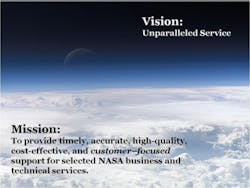Lockheed Martin engineers recreate Sensor Test for Orion Relative Navigation Risk Mitigation in Space Operations Simulation Center
DENVER, 6 Sept. 2011. Lockheed Martin [NYSE:LMT] engineers have completed an orbital simulation test at the company’s Space Operations Simulation Center (SOSC), using hardware and data previously flown on the NASA STS-134 space shuttle Endeavour mission to the International Space Station (ISS). The Sensor Test for Orion Relative Navigation Risk Mitigation (STORRM) test demonstrated the SOSC’s ability to provide a simulated space dynamics and lighting environment able to replicate on-orbit conditions and effects on navigation, lighting, and motion control in space.
The Endeavour crew tested the STORRM unit's Docking Camera and Vision Navigation Sensor (VNS), a navigation sensor suite developed for Orion and other future spacecraft, while performing docking/undocking operations during the STS-134 mission. The SOSC's large motion base carriage, on which the VNS eye-safe laser ranging system was mounted, is designed to provide six degrees of spacecraft motion at equivalent rates in the approach and departure trajectories identical to STS-134. The target environment included a full-scale, high-fidelity mockup of a space station docking port equipped with reflective sensors.
STORRM demonstrates a “robust relative navigation design that provides the required docking accuracy and range capability necessary to meet crew safety, mass, volume, and power requirements for a wide variety of future NASA missions, including those into deep space,” says a spokesperson.
The flight test further provided the opportunity for in-flight collaboration of NASA's three human spaceflight programs: Space Shuttle, International Space Station, and the Orion Multi-Purpose Crew Vehicle (MPCV).
"The test went perfectly and we were able to recreate the STS-134 STORRM test in a flight-like environment right here on Earth," says John Karas, vice president and general manager, Human Space Flight, Lockheed Martin Space Systems Company. "We'll compare the data and telemetry we collected in the lab with the on-orbit data and telemetry to calibrate the SOSC to a real space environment, further increasing the fidelity of this extraordinary facility for future simulations."
Lockheed Martin's SOSC test environment replicated the hardware, lighting conditions. and vehicle motion that was observed on orbit, validating its ability to provide an on-orbit simulation environment for critical risk mitigation for the Orion spacecraft.
The STORRM technology development effort is led by NASA's Multi-Purpose Crew Vehicle Program Office at NASA Johnson Space Center in partnership with NASA Langley Research Center, Lockheed Martin Space Systems Company, and Ball Aerospace & Technologies Corp. The technology also has Earth-bound applications for terrain mapping, robotics, military operations, and transportation, including collision-avoidance systems for vehicles.
Lockheed Martin is the prime contractor to NASA for the Orion MPCV Program and leads an industry team of subcontractors and small businesses.
